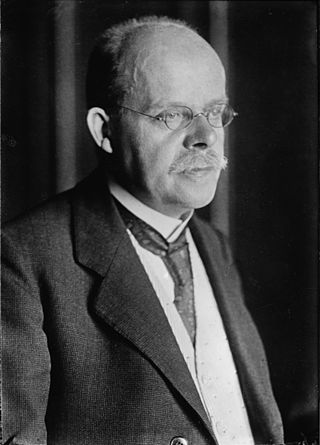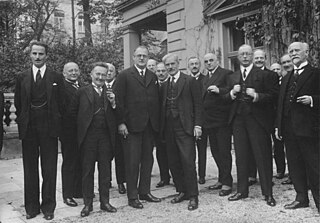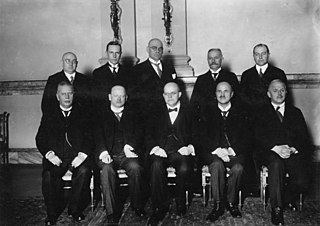
The German People's Party was a conservative-liberal political party during the Weimar Republic that was the successor to the National Liberal Party of the German Empire. Along with the left-liberal German Democratic Party (DDP), it represented political liberalism in Germany between 1918 and 1933.

Wilhelm Carl Josef Cuno was a German businessman and politician who was the chancellor of Germany from 1922 to 1923, for a total of 264 days. His tenure included the episode known as the Occupation of the Ruhr by French and Belgian troops and the period in which inflation in Germany accelerated notably, heading towards hyperinflation. Cuno was also general director of the Hapag shipping company.

Wilhelm Marx was a German judge, politician and member of the Catholic Centre Party. During the Weimar Republic he was the chancellor of Germany twice, from 1923–1925 and 1926–1928, and served briefly as the minister president of Prussia in 1925. With a total of 3 years and 73 days, he was the longest-serving chancellor during the Weimar Republic.

The Rentenmark was a currency issued on 15 November 1923 to stop the hyperinflation of 1922 and 1923 in Weimar Germany, after the previously used "paper" Mark had become almost worthless. It was subdivided into 100 Rentenpfennig and was replaced in 1924 by the Reichsmark.

Karl Rudolf Heinze was a German jurist and politician. During the Weimar Republic, as a member of the right-of-centre German People's Party (DVP) he was vice-chancellor of Germany and minister of Justice in 1920/21 in the cabinet of Konstantin Fehrenbach and from 1922 to 1923 again minister of Justice under Wilhelm Cuno.

The Great Coalition was a grand coalition during the Weimar Republic that was made up of the four main pro-democratic parties in the Reichstag:

The Scheidemann cabinet, headed by Minister President Philipp Scheidemann of the Social Democratic Party (SPD), was Germany's first democratically elected national government. It took office on 13 February 1919, three months after the collapse of the German Empire following Germany's defeat in World War I. Although the Weimar Constitution was not in force yet, it is generally counted as the first government of the Weimar Republic.

The Bauer cabinet, headed by Gustav Bauer of the Social Democratic Party of Germany (SPD), was the second democratically elected government during the Weimar Republic. Bauer's title was minister president until the Weimar Constitution came into force on 14 August 1919, after which he became chancellor of Germany. The cabinet took office on 21 June 1919 when it replaced the Scheidemann cabinet, which had resigned the day before in protest against the terms of the Treaty of Versailles. Although the Weimar Constitution was not in force at the time, the Bauer cabinet is generally counted as the second government of the Weimar Republic.

The first Müller cabinet, headed by Chancellor Hermann Müller of the Social Democratic Party of Germany (SPD), was the third democratically elected government of Germany and the second in office after the Weimar Constitution came into force in August 1919. The cabinet was based on the same three centre-left parties as the preceding Bauer cabinet: the SPD, Centre Party and German Democratic Party (DDP), a grouping known as the Weimar Coalition. It was formed on 27 March 1920 after the government of Gustav Bauer (SPD) resigned as a result of the unsuccessful Kapp Putsch, which it was seen as having handled badly.

The Fehrenbach cabinet, headed by Chancellor Constantin Fehrenbach of the Centre Party, was the fourth democratically elected government of the Weimar Republic. It took office on 25 June 1920 when it replaced the first cabinet of Hermann Müller, which had resigned due to the poor showing of the coalition parties in the June 1920 elections to the new Reichstag. The 1920 Reichstag replaced the Weimar National Assembly, which had served as Germany's interim parliament and written and approved the Weimar Constitution.

The first Wirth cabinet, headed by Chancellor Joseph Wirth of the Centre Party, was the fifth democratically elected government of the Weimar Republic. On 10 May 1921 it replaced the Fehrenbach cabinet, which had resigned as a result of differing opinions among its members over the payment of war reparations to the Allied powers. It was based on the Weimar Coalition made up of the Social Democratic Party (SPD), the Centre Party and the German Democratic Party (DDP).

The second Wirth cabinet, headed by Joseph Wirth of the Centre Party, was the sixth democratically elected government of the Weimar Republic. It assumed office on 26 October 1921 when it replaced the first Wirth cabinet, which resigned in protest after the industrially important eastern part of Upper Silesia was awarded to Poland even though the majority of its inhabitants had voted in a plebiscite to remain part of Germany.

The Cuno cabinet, headed by Chancellor Wilhelm Cuno, a political independent, was the seventh democratically elected government of the Weimar Republic. It took office on 22 November 1922 when it replaced the second cabinet of Joseph Wirth, which had resigned after being unable to restructure its coalition following the loss of a key vote in the Reichstag.

The second Stresemann cabinet, headed by Chancellor Gustav Stresemann of the German People's Party (DVP), was the ninth democratically elected government of the Weimar Republic. It took office on 6 October 1923 when it replaced the first Stresemann cabinet, which had resigned on 3 October over internal disagreements related to increasing working hours in vital industries above the eight-hour per day norm. The new cabinet was a majority coalition of four parties from the moderate left to centre-right.

The first Marx cabinet, headed by Wilhelm Marx of the Centre Party, was the tenth democratically elected government during the Weimar Republic. It took office on 30 November 1923 when it replaced the Second Stresemann cabinet, which had resigned on 23 November after the Social Democratic Party (SPD) withdrew from the coalition. Marx's new cabinet was a minority coalition of three centre to centre-right parties.

The second Marx cabinet, headed by Wilhelm Marx of the Centre Party, was the 11th democratically elected government during the Weimar Republic. It took office on 3 June 1924 when it replaced the first Marx cabinet, which had resigned on 26 May following the unfavourable results of the May 1924 Reichstag election. The new cabinet, made up of the Centre Party, German People's Party (DVP) and German Democratic Party (DDP), was unchanged from the previous one. The three coalition parties ranged politically from centre-left to centre-right.

The first Luther cabinet, headed by the political independent Hans Luther, was the 12th democratically elected government of the Weimar Republic. It took office on 15 January 1925, replacing the second cabinet of Wilhelm Marx, which had resigned when Marx was unable to form a new coalition following the December 1924 Reichstag election. Luther's cabinet was made up of a loose coalition of five parties ranging from the German Democratic Party (DDP) on the left to the German National People's Party (DNVP) on the right.

The second Luther cabinet, headed by the independent Hans Luther, was the 13th democratically elected government of the Weimar Republic. On 20 January 1926 it replaced the first Luther cabinet, which had resigned on 5 December 1925 following the withdrawal of the German National People's Party (DNVP) from the coalition in protest against the government's support of the Locarno Treaties. Luther had wanted to build a more stable majority coalition but had to settle for a second minority government with the same parties as his first cabinet but without the DNVP.

The third Marx cabinet, headed by Wilhelm Marx of the Centre Party, was the 14th democratically elected government during the Weimar Republic. On 17 May 1926 it replaced the second Luther cabinet after the resignation of Chancellor Hans Luther (independent) four days earlier. The Reichstag had passed a vote of censure against him for supporting a decree that permitted flying a German trade flag with the colours of the former German Empire in certain mostly overseas locations. The new Marx cabinet was a four-party centrist minority government.

The fourth Marx cabinet, headed by Wilhelm Marx of the Centre Party, was the 15th democratically elected government during the Weimar Republic. On 29 January 1927 it replaced the third Marx cabinet, which had resigned after information concerning clandestine operations by Germany's armed forces, the Reichswehr, had come to light.
.



















